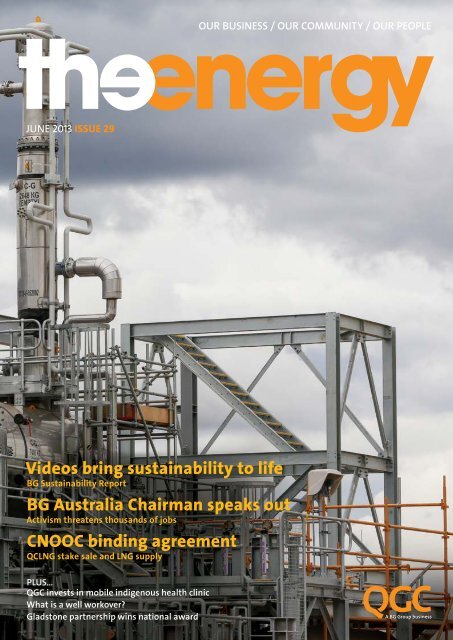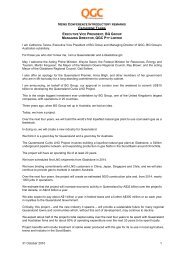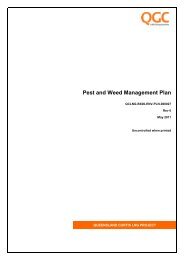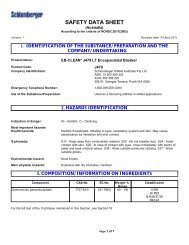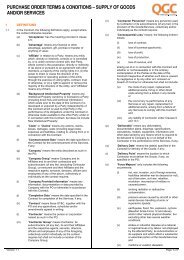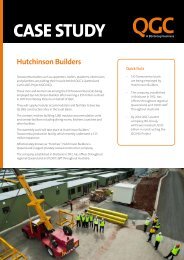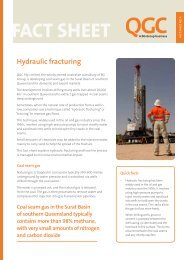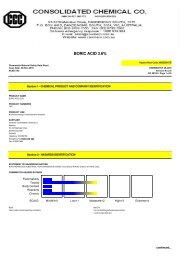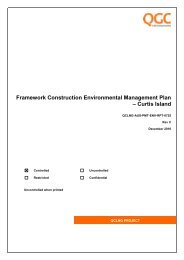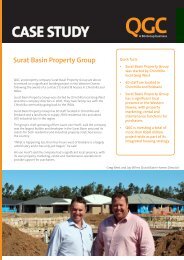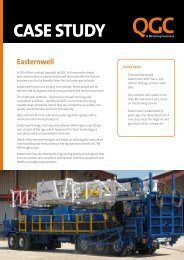Videos bring sustainability to life BG Australia Chairman ... - QGC
Videos bring sustainability to life BG Australia Chairman ... - QGC
Videos bring sustainability to life BG Australia Chairman ... - QGC
- No tags were found...
You also want an ePaper? Increase the reach of your titles
YUMPU automatically turns print PDFs into web optimized ePapers that Google loves.
our business / our community / our peopleJune 2013 Issue 29<strong>Videos</strong> <strong>bring</strong> <strong>sustainability</strong> <strong>to</strong> <strong>life</strong><strong>BG</strong> Sustainability Report<strong>BG</strong> <strong>Australia</strong> <strong>Chairman</strong> speaks outActivism threatens thousands of jobsCNOOC binding agreementQCLNG stake sale and LNG supplyPLUS…<strong>QGC</strong> invests in mobile indigenous health clinicWhat is a well workover?Glads<strong>to</strong>ne partnership wins national award
our business JUNE 2013Page 5
Workers rose <strong>to</strong> the challenge atthe David siteGas Fields UPDATEOperation David - a success s<strong>to</strong>ryIn February 2013, <strong>QGC</strong>’sgeneral manager for Upstreamcompression, Karl Roberts, seta challenge for the <strong>QGC</strong> andTheiss people working onthe David field compressionstation (FCS), about 35km wes<strong>to</strong>f Dalby.Their mission, named‘Operation David’ was <strong>to</strong>ensure construction of theDavid FCS was mechanicallycompleted in eight weeks.<strong>QGC</strong> and Thiess ‘joinedforces’ <strong>to</strong> work in an intensivestyle, designed <strong>to</strong> acceleratethe completion of the fieldcompression station. Theobjective of Operation Davidwas <strong>to</strong>:• increase momentum andworkflow through a handsoncampaign• give teams a sense ofachievement as they seeon-the-ground progress• test constructionprocesses, quality controldocumentation andmechanical completionprocess at an early stage• assess the potential for earlypre-commissioning.Additional resources andinfrastructure were mobilised<strong>to</strong> the David site. The operationincluded a night shift, withwork crew numbers increasingmore than 100 per cent fromaround 50 people working dayshift <strong>to</strong> 80 people on the daycrew and 30 people workingon a night shift.The team set up a room onsite<strong>to</strong> use the managementtechnique of ‘Work, Assessand Recover’.This team set work targetsfor the crews twice a day andprovided an immediate hubfor decision making.The tactics tracked progressevery 12 hours andmitigated construction andtechnical issues.Karl said the style of commandand control employed at Davidwas typical of short-termintensive plant shutdownmaintenance.“Having everyone in thesame room <strong>to</strong> assessproblems and make decisions<strong>to</strong> keep Operation Davidrunning was critical,” he said.“<strong>QGC</strong>’s constructionmanagement team were doingwhat they do best; directingcomplex teams, achievingdaily targets and addressingany materials shortfalls ortechnical road-blocks wherenecessary.”Operation David wassuccessfully completedin April.Karl Roberts said he was proudof the team spirit shownby the crews <strong>to</strong> completethe project on time and <strong>to</strong>project specification.Now that the David site ismechanically complete, themajority of the work crewswill be re-deployed <strong>to</strong> theRuby Jo central processingplant and the Isabella fieldcompression station.This style of working is beingconsidered by <strong>QGC</strong> for futureprojects.The crews may have leftthe David site, but work isongoing <strong>to</strong> connect the fieldcompression station <strong>to</strong> waterand gas gathering lines.A small crew has been retained<strong>to</strong> complete connectionof power <strong>to</strong> the site and <strong>to</strong>test low-voltage power andcompression control systems.Page 6 our business JUNE 2013
Project UpdateUpstream Project Direc<strong>to</strong>rTheo RoderburgAcross the Upstream, teamsare working hard <strong>to</strong> deliverthe equipment, infrastructureand construction we need <strong>to</strong>produce first LNG in 2014.Safety remains our priority.Our One Team of <strong>QGC</strong> staffand contrac<strong>to</strong>rs has a systemof observing workplaces andbehaviours and speaking upand intervening when we thinkhealth and safety performancecould be improved.In 2013 we have completedmore than 4,000 observationsand interventions andI am encouraging teams <strong>to</strong>keep putting safety first.<strong>QGC</strong> regularly holds safetytraining for supervisors andWorleyParsons and Toll at theMiles supply base. The purposeis <strong>to</strong> ensure our approach isaligned with our contrac<strong>to</strong>rs.Project wise, we are makinggood progress. Well-siteinstallations are a critical par<strong>to</strong>f delivering the UpstreamProject and we’re upping thepace on this work. April saw47 well sites reach mechanicalcompletion, a great effort bythe team.Construction of our fieldcompression stations isprogressing <strong>to</strong> plan.On the opposite page you canread about a way of workingwe recently piloted at the Davidfield compression station. Itwas a successful trial of frontloading<strong>QGC</strong> and contrac<strong>to</strong>rresources <strong>to</strong> complete theDavid site in eight weeks.Other Southern region fieldcompression stations areprogressing well.At the Ruby Jo site all civilworks are completed,major equipment has beeninstalled and hydrotestinghas commenced.At the Harry site the flare stackhas been installed along witha metering skid and InterimLocal Equipment Room switchrooms are in place at bothHarry and Broadwater fieldcompression stations.In addition <strong>to</strong> the relocatablewater treatment plant nowrunning 24 hours a day atKenya, water was pumpedfor the first time through thereverse osmosis system at thelarger Kenya water treatmentplant on 1 May.The water was pumpedmanually and work is nowcontinuing <strong>to</strong> fine tune theau<strong>to</strong> sequence.The Kenya water treatmentplant is expected <strong>to</strong> becompleted in the third quarterof this year.Work on our camps is movingahead swiftly <strong>to</strong> provide acomfortable base for our siteworkers. Permanent water,power and sewage servicesare now in place at the RubyJo main camp.This facility has more than660 beds and recently passeda miles<strong>to</strong>ne inspection.Plus, an additional 240 bedsare now ready for use atthe Ruby Jo constructioncamp and a further 150 bedshave come online at theJordan camp.Across the Upstream, crewshave been working hard <strong>to</strong>:• complete strength testing ongathering lines as part of theoperation <strong>to</strong> complete theDavid field compression site• get the pad ready for pilingat the Bellevue centralcompression station• complete all structuralsteel at the WoleebeeCreek substation• place the instrumentrooms at Broadwater fieldcompression stationThe Chinchilla OperationsCentre is now up and runningin Taylor Street, giving theUpstream Projects teama direct operations andcommand link <strong>to</strong> colleaguesin Brisbane and sites acrossthe Surat Basin.At the Ruby Jo site all civil works are completed, major equipment has been installed and hydrotesting has commencedour business JUNE 2013Page 7
Lowering in pipes at Specimens Hillin the in Callide Range, 24km Southof Glads<strong>to</strong>nePipeline UPDATEA string of miles<strong>to</strong>nesThe first pipe has been loweredin<strong>to</strong> the ground on CurtisIsland, the latest in a stringof miles<strong>to</strong>nes for the QCLNGpipelines team.While the severe weatherand flooding slowed pipelineconstruction earlier this year,pipeline activities are back <strong>to</strong> anormal level and the pipelinesteam expects <strong>to</strong> make up losttime in the coming months.All of the 200 kilometre GasCollection Header is now inthe ground and has beenbackfilled. Around 95% of themainline welding for the 340kilometre Export Pipeline iscomplete, with around 60%of the pipeline lowered in<strong>to</strong>the ground.Following the successful pipepull, the focus in Glads<strong>to</strong>neHarbour has shifted <strong>to</strong>covering the pipelines withrock for protection.An excava<strong>to</strong>r working off abarge is backfilling the trench,initially with 2cm-4cm rockand then with rock up <strong>to</strong> 38cmin diameter, until the sea bedis level. The work is expected<strong>to</strong> take about three monthsin <strong>to</strong>tal.Horizontal directional drillingacross creek sections of TheNarrows Crossing Projecthas been completed and the1.46km of pipe was pulledthrough in late May.The most high profile crossinghas been at ColumboolaCreek, near Miles, which is awater source for a numberof landholders.<strong>QGC</strong> and its contrac<strong>to</strong>rs,in consultation with theDepartment of Environmentand Heritage Protectionand impacted landholders,<strong>to</strong>ok all the necessary steps<strong>to</strong> ensure that the work wascompleted in accordance withour environmental approvals.<strong>QGC</strong> uses best-practicewaterway crossingtechniques as defined bythe <strong>Australia</strong>n PipelineIndustry Association’s Codeof Environmental Practice.No nationally protectedplants or animals recordedduring site surveys conductedby specialist consultants anda specialist independentexpert certified erosion andsediment control plans.Page 8 our business JUNE 2013
Project UpdateAfter the disruptions causedby severe wet weather inthe first quarter of this year,our emphasis has been onremobilising additionalconstruction crews <strong>to</strong> increasecapacity and move closer <strong>to</strong>mechanical completion.An excava<strong>to</strong>r backfilling the trench across The NarrowsPipe in the ground at Curtis IslandLowering in pipelineWork continues at the Curtis Island side end of The NarrowsAlong the 540 kilometreQCLNG pipeline network,mainline construction activitiesare now progressing <strong>to</strong>wardscompletion. Accordingly, weare increasingly focused onback-end activities such asroad, creek, railway and thirdpartyutility crossings, weldingtie-in sections, hydrostatictesting and reinstatement.All the 200 kilometreGas Collection Headeris now buried and recently wechalked up another miles<strong>to</strong>newith the completion of the11.4 kilometre Kenya Lateralnear Chinchilla. Hydrostatictesting is also movingahead on the Gas CollectionHeader, with over 40% (80kilometres) of the pipelinesuccessfully completed.Reinstatement activitiesare in full swing along theGas Collection Header. Par<strong>to</strong>f the focus has been in theGuluguba area near Wandoan,where the wet weatherhad the beneficial effect ofencouraging regrowth alongthe easement.On the Export Pipeline thelast remaining part of the 540kilometre easement has nowbeen cleared and graded.Good headway is also beingmade on stringing and bendingalong the Export Pipelineas we near completion ofthese activities.Hydrostatic testing has alsoProject Direc<strong>to</strong>r PipelinesNorman Ingramcommenced on the ExportPipeline, with the first testsection (26 kilometres)successfully completed.On The Narrows CrossingProject our focus after thesuccessful pipe pull hasmoved <strong>to</strong> backfilling the 2.3kilometre trench across theNarrows Channel and the1.5 kilometre cofferdam onthe mainland. Constructionactivities are also progressingon Curtis Island, and thefirst pipe section hasbeen lowered in betweenthe Delivery Station andLNG Plant.As always, safety is at theforefront of our minds andthis has been demonstrated byan improvement in our safetyrecord on the QCLNG pipelinefor the first quarter of 2013.I am particularly pleased that inthe first quarter there were nodriving-related incidents. Thisis our highest risk activity, withthe risk heightened during wetweather conditions.Moving forward, the QCLNGpipeline team will continue <strong>to</strong>build on this foundation andstrive <strong>to</strong> ensure that everybodygets home safely.our business JUNE 2013Page 9
lng plant UPDATERapidly changing landscapeIt’s been a busy time at CurtisIsland, with the project markinganother miles<strong>to</strong>ne with thefinal three modules for the firstTrain of the liquefied naturalgas (LNG) plant arriving.This marked the 16th moduleshipment <strong>to</strong> have come fromThailand: 13 from roll-on roll-offvessels and three from lift-onlift-off vessels.The subsequent arrival ofthe first three modulesfor Train 2 signifies that 65out of a <strong>to</strong>tal of 80 moduleshave been successfullydelivered <strong>to</strong> site.The site has now received allof the major process plantcomponents for Train 1 <strong>to</strong>produce more than 4 million<strong>to</strong>nnes a year of LNG.On Curtis Island installation ofthe first fibre optic cable fromthe main control building <strong>to</strong> theTrain 1 compressor sub-stationwere pulled.The first fibre optic cableswere pulled from the maincontrol room <strong>to</strong> the Train 2compressor building.The fibre optic cables arecritical means by which plan<strong>to</strong>pera<strong>to</strong>rs control the variousprocess units and supportservices of the LNG plant.Work on the installation of theLNG jetty support risers andfour loading arms has beencompleted.The fourth of six mooringdolphin pylon structures forthe jetty have been concreted.Work has started on theinstallation of marine terminalbuilding pre-cast concretedeck beams.All five substations on site areunder a controlled environment– with the heating, venting andair-conditioning units nowunder 24-hour operation.The first internal concrete layerwas placed over the carbonsteel floor in LNG Tank B andthe first foam glass insulationblocks have been placed on it.Page 10 our business JUNE 2013
Project UpdateSolid progress continues <strong>to</strong>be made on the Midstreamproject at Curtis Island.In terms of physical completion,the Curtis Island site is a rapidlychanging landscape.An aerial view of the QCLNG site at Curtis IslandThe site has now received all major process components for Train 1Tank work continues on both LNG tanks at Curtis IslandGas turbine genera<strong>to</strong>rs which will power the LNG plantWe have now received all ofthe Train 1 and associatedsupport modules such as gasturbine genera<strong>to</strong>rs from ourThailand assembly yard: a <strong>to</strong>talof 65 modules.Foam glass insulation is beinginstalled in LNG Tank B and theninth of ten wall lifts has beencompleted on Tank A.Also of great interest is theprogress on the jetty for LNGloading where the final steeldecking and loading arms wererecently installed.In our impact mitigationsover 100 people now receiverent assistance under aprogram funded by <strong>QGC</strong>and delivered by Glads<strong>to</strong>neRegional Council.Through April, contractswere also executed forthe construction of 14dwellings comprising eight<strong>to</strong>wnhouses and six house andland packages.Of the many achievements,however, the most pleasingand significant is the continualimprovement in Midstream’ssafety performance.As at April, the Curtis Islandand Thailand workforceshave not experienced any losttime injuries in the 2013calendar year.Project Direc<strong>to</strong>r MidstreamDavid CraftFurthermore, the project’s<strong>to</strong>tal recordable case frequencyrate or recordable injuries permillion hours worked, standsat 1.28 year <strong>to</strong> date.While this effort iscommendable, furtherimprovements are achievableand I look forward <strong>to</strong> theeffort invested in<strong>to</strong> our OneTeam approach with Bechtelpaying big dividends as theyear unfolds.Overall, Midstream hasnow passed 18 million manhours and a major effortis occurring in the qualityassurance aspects of theconstruction program.As we progress through theconstruction program, thehandover of the plant <strong>to</strong> our<strong>QGC</strong> operations team in 2014is now firmly in sight.We have an experiencedcommissioning team alreadyin place and it gives megreat confidence <strong>to</strong> see thecollaboration that is occurringbetween the commissioningand operations teams.our business JUNE 2013Page 11
<strong>Chairman</strong> visit headlineLeft <strong>to</strong> right: <strong>BG</strong> Group’s COO Martin Hous<strong>to</strong>n,<strong>Chairman</strong> Andrew Gould and <strong>QGC</strong>’s ManagingDirec<strong>to</strong>r Derek Fisher speak <strong>to</strong> Chinchilla staffStaff meet the <strong>Chairman</strong>Commends progress made at <strong>QGC</strong>Two hundred field staff had aconversation with <strong>BG</strong> Group<strong>Chairman</strong> Andrew Gould whenhe visited <strong>Australia</strong> recently.Andrew, who spoke alongside<strong>BG</strong> Group Chief OperatingOfficer Martin Hous<strong>to</strong>n and<strong>QGC</strong> Managing Direc<strong>to</strong>r DerekFisher, was visiting <strong>QGC</strong> for thesecond time.“The progress that has beenmade at <strong>QGC</strong> in the lastyear and a half is really quiteextraordinary,” Andrew said.He praised <strong>QGC</strong>’s safetyperformance this year andnoted that the number ofwells <strong>to</strong> be drilled in <strong>Australia</strong>this year was far higher thanin any other <strong>BG</strong> Group asset.Andrew said that <strong>QGC</strong>’sexperiences in working withcommunities were vital <strong>to</strong> thebroader Group in developingunconventional resourcesand had already informedapproaches in other countries.He also addressed a <strong>QGC</strong>Women’s Network event,noting that businesses needed<strong>to</strong> accept differences betweenthe sexes if they were <strong>to</strong> makethe most of people’s potential.“The debate is richer withboth genders in the room,”Andrew <strong>to</strong>ld about 100women in Brisbane.“Men and women reasondifferently and each havetheir own strengths andweaknesses.”Andrew said that increasingthe proportion of women indecision-making positionswould only come aboutthrough cultural change ledby management.“Why deprive yourself of 50%of the world’s intellectualcapital?” he said.Andrew, who was formerlychairman and chief executiveof the oil and gas servicescompany Schlumberger, saidthat such change was possiblebut <strong>to</strong>ok time.He said that Schlumbergerwas now a leader in diversitybut had taken decades <strong>to</strong>embrace fully gender andcultural differences.<strong>BG</strong> Group <strong>Chairman</strong> Andrew Gould meets PM Julia GillardPage 12 our business JUNE 2013
Binding agreements signed forQCLNG stake sale and LNG supplyFederal Minister for Resourcesand Energy Gary Gray said theagreement for China NationalOffshore Oil Corporation(CNOOC) <strong>to</strong> take a greaterinterest in Queensland CurtisLNG reaffirmed <strong>Australia</strong>as a leader in supplyingcleaner hydrocarbon energy<strong>to</strong> global markets.In May, <strong>QGC</strong>’s parent company<strong>BG</strong> Group signed bindingagreements with CNOOC forthe sale of further interests inthe QCLNG project for US$1.93billion and for the supplyof an additional 5 million<strong>to</strong>nnes a year of LNG from itsglobal portfolio.“Following the PrimeMinister’s successful visit<strong>to</strong> China our two countriesannounced a strategicpartnership and the supplyof minerals and petroleum,and increasingly LNG, is akey plank in our broaderrelationship,” Mr Gray said.“Ours is a mutually beneficialpartnership. China is theworld’s fastest growing energymarket, with huge demandfor LNG, at the same time as<strong>Australia</strong> is poised <strong>to</strong> becomeone of the world’s <strong>to</strong>p two LNGexporters.“The future of LNG productionis in <strong>Australia</strong> and <strong>to</strong>day’sagreement demonstrates weare increasing our capabilitiesin LNG construction andoperation through a focuson innovation and the rightapproach from governmentand industry.”Mr Gray attended the signingceremony in Brisbane along withQueensland Deputy PremierJeff Seeney; QueenslandMinister for Natural Resourcesand Mines Andrew Cripps;CNOOC Group <strong>Chairman</strong>Wang Yilin; and <strong>BG</strong> GroupChief Executive Chris Finlayson– all hosted by <strong>BG</strong> <strong>Australia</strong><strong>Chairman</strong> Catherine Tanna.As part of the agreementssigned in early May, whichbuilt on a heads of agreementsigned in Oc<strong>to</strong>ber 2012,CNOOC will acquire a 20 percent interest in the reservesand resources of certain<strong>BG</strong> Group tenements in theWalloons Fairway regionof the Surat Basin. CNOOCwill also increase its equityownership of QCLNG Train 1from 10% <strong>to</strong> 50%.<strong>BG</strong> Group’s <strong>Australia</strong>n business<strong>QGC</strong> Pty Limited remainsopera<strong>to</strong>r and retains majorityownership of QCLNG.Mr Finlayson said: “Combinedwith the 3.6 million <strong>to</strong>nnesper annum (mtpa) LNG saleagreement signed withCNOOC in 2010, <strong>BG</strong> Groupnow has <strong>to</strong>tal committedvolumes <strong>to</strong> China of 8.6 mtpawhich will make the Groupthe largest supplier of LNG <strong>to</strong>the world’s fastest growingenergy market.”He said that CNOOC, asa foundation partner inQCLNG, was among thefirst <strong>to</strong> recognise the valueand strategic importance ofthis world-first project – avision that is now coming <strong>to</strong>fruition as first LNG in 2014draws closer.“More broadly, the agreementsexpand our strong LNGposition in the Asia-Pacificregion, where we are onschedule with our LNG exportproject on Curtis Island inQueensland; where we havesigned long-term LNG salescontracts with cus<strong>to</strong>mers inChina, Japan and India; and,where we will soon beginimporting LNG in<strong>to</strong> Singaporethrough our position as solegas market aggrega<strong>to</strong>r,” MrFinlayson said.Jeff Seeney, Queensland Deputy Premier and Minister for StateDevelopment, Infrastructure and PlanningCNOOC Group <strong>Chairman</strong> Wang Yilin (left) and <strong>BG</strong> Group Chief ExecutiveChris FinlaysonGary Gray, Federal Minister for Resources and Energyour business JUNE 2013Page 13
Catherine Tanna at the American Chamberof Commerce in <strong>Australia</strong> eventchairman speaks outActivism threatens thousands of jobsFollowing is an abridgedtext of a speech given inBrisbane by <strong>BG</strong> <strong>Australia</strong><strong>Chairman</strong> Catherine Tanna<strong>to</strong> the American Chamber ofCommerce in <strong>Australia</strong>.In this age of climate change– and while renewableenergy options do not yethave the characteristics orscale <strong>to</strong> meet rising energydemand – natural gas, withits relatively low emissions,will remain an important par<strong>to</strong>f <strong>Australia</strong>’s and the world’senergy mix.I take great satisfactionbeing part of an industrythat is helping people <strong>to</strong>breathe cleaner air in someof the developing world’smost populated cities and isproviding electricity so peopledo not have <strong>to</strong> cook usingfirewood, coal or cow dung.At home, the industry nowprovides more than 90% ofQueensland’s <strong>to</strong>tal gas supply,firing power stations, runningbuses, heating meals.That said, the gas industry hasbeen criticised on many fronts.Very occasionally that criticismis warranted and the industryhas been quick <strong>to</strong> remediate.A lot of what is said, though,is highly questionable, andpropagated without challenge<strong>to</strong> the point where activismdetermines public policy;where the tail wags the dog.A prime example is inproposed amendments <strong>to</strong>the federal EnvironmentProtection and BiodiversityConservation Act, introducedin haste <strong>to</strong> the FederalParliament in March this year.The proposals aim <strong>to</strong>broaden the Act <strong>to</strong> make“water resources” a matterof national environmentalsignificance and <strong>to</strong> make justtwo industries – coal andnatural gas – subject <strong>to</strong> thenew law when they have, infact, a relatively small impac<strong>to</strong>n <strong>Australia</strong>’s water.To illustrate, coal andnatural gas use less than4% of <strong>Australia</strong>’s water.Agriculture uses more than50%. Agriculture can havesignificant impact on waterquantity and quality.Page 14 our business JUNE 2013
If these proposals were,therefore, designed <strong>to</strong> protect<strong>Australia</strong>’s water resources,they fail on this logic alone.They were clearly notintroduced <strong>to</strong> deal with anenvironmental problem.They were introduced <strong>to</strong>appease activists.live in their home <strong>to</strong>wns.That is a measure of whatis at stake when we havedecision making on this basis;when green activists andtheir supporters deliberatelymisinform; and when motivesand charges go unquestionedand unchallenged.how they work, how theytreat people, how they dealwith success, and how theydeal with failure.They work hard at understandingwhat drivespeople; what makes themhappy; what makes them sad;what makes them excited.<strong>to</strong> change; the capacity <strong>to</strong>make a difference. In tappingthat capacity, we have <strong>to</strong>believe in something, <strong>to</strong>stand for something.With good intentions,courage and authenticity, wecan own and lead the changewe seek.We have not, of course,advocated that agriculturebe included in the Bill. Wehave, instead, asked that theBill be withdrawn.We believe the proposalsare fundamentally flawedbecause they deal witha fabricated perceptionand not with reality, andwill effectively shift theregula<strong>to</strong>ry goal posts forprojects already approvedby a regula<strong>to</strong>ry regime thatalready works.When fully operational, ourbusiness will contribute morethan A$1 billion a year <strong>to</strong> stateand federal governmentrevenues.That’s equivalent yearlyfunding for more than 20primary schools or about1000 hospital beds.Most importantly, a newspecialised sec<strong>to</strong>r has beencreated, diversifying oureconomy, and creatingnew, skilled, well-paid jobsin regional Queenslandcommunities like Glads<strong>to</strong>ne,Chinchilla, Tara and Dalby.Projects like ours are alsorejuvenating the bush,increasing school enrolments,leading <strong>to</strong> better healthservices, improving roadsand, critically, giving youngpeople a reason <strong>to</strong> work andLeadershipIn practical terms, the lessonsof leadership that I havefound most helpful over theyears have not come fromtextbooks.They have come fromwonderful men<strong>to</strong>rs and theyhave been deeply personal– that is, they are in all of uswhen we look.In my case, I have learnedthat leadership is “owned”by people who lead.They believe in something;they hold their values dearly.I take great satisfactionfrom being part of anindustry that is helpingpeople <strong>to</strong> breathecleaner air in some ofthe developing world’smost populated citiesand is providingelectricity so peopledo not have <strong>to</strong> cookusing firewood,coal or cow dung.They “own” everything theydo – and take responsibilityfor how they behave, howthey speak, how they listen,They refuse <strong>to</strong> be limited byself-doubt, by what peoplemight think, by their ownsense of worth.They have a go.They are courageous.And, most importantly, theyare authentic.They have good intentions– and by this I don’t meana comparison with badintentions; I mean acomparison with having nointentions at all.They say what they mean;they mean what they say.Whether we talk aboutbusiness, politics, religion,sport, science, education,or community, we seem <strong>to</strong>have become a nation thatis crying out for leadership.We commonly hear ourselvestalking about “them” and“they” as those responsiblefor what we sense is a lackof leadership: a failureof “those at the <strong>to</strong>p” <strong>to</strong>make difficult decisions, apropensity for them <strong>to</strong> makeself-interested decisions,and most damning, their lackof intention.It has become easy <strong>to</strong>“outsource” our ailments.We have within each of us thecapacity <strong>to</strong> lead; the capacityThis leads me <strong>to</strong> what Ihave found <strong>to</strong> be the mostuseful question asked bymy business men<strong>to</strong>rs andapplicable <strong>to</strong> every problemI have faced in my businessand personal <strong>life</strong>: So what?I have learned that goodleaders encourage people<strong>to</strong> explain their problems, <strong>to</strong>constructively criticise, and <strong>to</strong>challenge convention.Early in my career, I found itrelatively easy <strong>to</strong> explain thedetail of a problem only <strong>to</strong> beconfronted by much wisermen and women who wouldpatiently listen and then ask:So what do we do about it?This was more difficult; Ihad <strong>to</strong> be more thoughtful;and the people who askedstand out in my <strong>life</strong> becausethey were able <strong>to</strong> createconstructs and environmentswhere people like me wereencouraged <strong>to</strong> work onsolutions.This often meant fixingsimple things first; notbecause they were simple asin easy but that they weresimple as in obvious, and theyrequired good-intentioned,courageous decisions.As a society, it is not enough<strong>to</strong> say things are broken; weneed <strong>to</strong> ask: “So what do wedo <strong>to</strong> fix them.”our business JUNE 2013Page 15
Promoting indigenous culture at ToolooaState High School in Glads<strong>to</strong>neSustainability report<strong>Videos</strong> <strong>bring</strong> <strong>sustainability</strong> <strong>to</strong> <strong>life</strong><strong>Videos</strong> have for the first timebrought <strong>to</strong> <strong>life</strong> <strong>BG</strong> Group’sannual Sustainability Report,with colour and commentaryfrom senior leaders at <strong>QGC</strong> andstaff working in the community.<strong>QGC</strong> features heavily in the2012 Sustainability Repor<strong>to</strong>f environmental, social andgovernance performancearound the world, which isindependently audited byinternationally recognisedthird-party experts, andassociated videos.The videos, which numberabout 20 and can be viewedon the websites of <strong>BG</strong> Groupand <strong>QGC</strong>, explain a rangeof approaches, from safety<strong>to</strong> water management andsocial investment.In introducing the videos,Sir John Grant, ExecutiveVice President of Policyand Corporate Affairs at<strong>BG</strong> Group, says: “It isvital that we understandour local stakeholdersin the places where weoperate, understand theirpreoccupations and align ouractions with their interests.”The report recognises thatsuccessful businesses canachieve commercial goals onlyif social and environmentalobjectives are set inconsultation with regula<strong>to</strong>rsand local communitiesultimately are reached.For example, a robustapproach <strong>to</strong> safety helps <strong>to</strong>ensure environmental bestpractice; while the attitudeof our people and contrac<strong>to</strong>rcompanies <strong>to</strong> safety andenvironment helps us <strong>to</strong>engage with the community.Following are some excerptsfrom <strong>QGC</strong>’s part of the report.EngagementDuring 2012, we extendedengagement andcommunication with all ourQueensland communities.An important change in theWestern Downs was theintroduction of regionalengagement co-ordina<strong>to</strong>rsbased in three informationcentres across the regioninstead of a single centrein Chinchilla. This change,including the opening of anoffice in Wandoan, the mostnortherly <strong>to</strong>wn in the area,has enabled us <strong>to</strong> be muchmore active across the wholeWestern Downs region.Engagement throughinformation centres,community events anddedicated communicationwith landowners and othercommunity members hasgenerated greater acceptanceof the industry’s willingness<strong>to</strong> discuss and work alongsidelandowners.Social investmentKey achievements during 2012included:• Developing an integratedhousing strategy forGlads<strong>to</strong>ne and the WesternDowns, investing inaffordable housing in theregion and contributingmore than A$6 million <strong>to</strong>local housing schemesand trusts;• Strengthening localworkforces by supportingapprentices and trainees innon-CSG skills <strong>to</strong> addressthe draw of local labour <strong>to</strong>the gas industry. More than100 apprentices and traineesare enrolled;• Support for communityprojects aimed atenhancing liveability andcommunity cohesion in thecommunities in which weoperate through the <strong>QGC</strong>Sustainable CommunitiesFund. The fund is investingup <strong>to</strong> A$6 million by 2014and has already supported110 community projects,spending A$3.4 millionduring the period since itslaunch in February 2011.Reporting and moni<strong>to</strong>ringDuring the year, wereported regularly <strong>to</strong> ourregional community consultativecommittees.These committees wereset up <strong>to</strong> provide regularrepresentation of communityviews <strong>to</strong> <strong>QGC</strong> and a forumfor information exchangebetween the companyand community representatives.Each committeerepresents a cross-sectionof the community.We also partneredwith the University ofQueensland’s Centre forSocial Responsibility inMining <strong>to</strong> achieve bestpractice in meeting oursocial responsibilities. Withthe centre, and our regionalcommittees, we developed<strong>sustainability</strong> indica<strong>to</strong>rs<strong>to</strong> measure our directimpact and contribution <strong>to</strong>the communities wherewe operate.You can read the report andwatch videos by visitinghttp://goo.gl/hwWLN or scanthis QR code.Page 16 our business JUNE 2013
Developing local contentMitch Ingram, QCLNG Project Direc<strong>to</strong>r‘One of the key things that I personally am looking for withinthe project community is <strong>to</strong> develop and maintain goodcontrac<strong>to</strong>rs. One of the challenges we’ve got is local contentand in the large parts of the project we have had <strong>to</strong> go <strong>to</strong>major contrac<strong>to</strong>rs who are in various parts of <strong>Australia</strong> andelsewhere. What we’re really looking <strong>to</strong> do now is <strong>to</strong> trainand develop local companies <strong>to</strong> help us for the next 10 yearsor 15 years with all these activities we’re doing.’A view on <strong>sustainability</strong>Derek Fisher, Managing Direc<strong>to</strong>r‘A project of this size, importance and longevity cannot besuccessful just <strong>to</strong> <strong>BG</strong> Group. It has <strong>to</strong> be successful for allthe external stakeholders, be that the State Government,local community, the contrac<strong>to</strong>r workforce, the man andwoman in the street. So it’s our objective <strong>to</strong> make sure thatthe success of this project, and the benefits, are sharedfar and wide. If we can do that, we will have a successful,sustainable project.’Community engagementBrett Smith, Vice President Sustainability‘For me, the biggest single indica<strong>to</strong>r of progress with acommunity has really been the fact that we’re now solvingproblems <strong>to</strong>gether. Once upon a time we just got problemshanded <strong>to</strong> us. Now we’ve got communities engaged: ‘well,we’ve got this issue, how can we solve it <strong>to</strong>gether?’ As somebodywho was born in Chinchilla, that’s what I value. I value workingwith the community and I see that we are becoming anotherintegral part of the entire community in the Surat Basin andthat’s really how I see us going forward <strong>to</strong>gether.’Partnership approachJane Roberts, Social Investment Manager‘For our bigger social investment commitments we’ll goand look for a partner. We’ll look for partners who alreadyexist because we want capable partners with a good trackrecord of delivering a particular service. We’ll work withthem <strong>to</strong> deliver an additional service, or over and abovewhat they’re already doing. It’s about <strong>bring</strong>ing ongoingbenefit <strong>to</strong> the community.’On-the-ground perspectiveOliver Blennerhassett, Land & Community Superintendent‘I believe in my position and the role we are playing in thecommunity. It’s an ongoing education of exactly what we aretrying <strong>to</strong> achieve and, alongside that, an understanding of howthe landholders are trying <strong>to</strong> operate as well. I’ve been in this rolefor a few years now and I have witnessed a huge improvementin interaction directly with the business and landholders at aground level. The key <strong>to</strong> it all I think is getting on it at a grassrootslevel and understanding their operation and how our objectivescan fit in and around that <strong>to</strong> achieve coexistence.’our business JUNE 2013Page 17
A Chinchilla local content forum connects<strong>QGC</strong> and businesses<strong>QGC</strong> creates 11,600 jobsA$9.6 billion invested with Queensland firmsMore than 11,600 people areworking with <strong>QGC</strong> and itsmajor contrac<strong>to</strong>rs, with morethan 15 people hired every dayduring the past six months.In <strong>QGC</strong>’s latest six-monthlyreport <strong>to</strong> Queensland’sCoordina<strong>to</strong>r-Generalon <strong>Australia</strong>n industryparticipation we reportedinvestment in construction,exploration and operationssince January 2010 had passedA$14.9 billion. This includedspending by both <strong>QGC</strong> andthe QCLNG Project.About A$12 billion - or 80%of the <strong>to</strong>tal A$14.9 billion- had been invested with<strong>Australia</strong>n firms since 1January 2010. Queenslandfirms had received 64.5%, orA$9.6 billion, of the <strong>to</strong>tal. Thereport covered 1 Oc<strong>to</strong>ber 2012<strong>to</strong> 31 March 2013.<strong>QGC</strong> Managing Direc<strong>to</strong>rDerek Fisher said more than115,300 <strong>Australia</strong>n businesseshad registered their interestin doing business with <strong>QGC</strong>since 2010.“<strong>QGC</strong> will be operating inQueensland for decades <strong>to</strong>come and our QCLNG Projectis delivering economic andsocial benefits from the SuratBasin <strong>to</strong> Glads<strong>to</strong>ne and acrossQueensland,” Mr Fisher said.“In the six months <strong>to</strong> theend of March, <strong>QGC</strong> and ourcontrac<strong>to</strong>rs hired more than2800 people - or 15 people a day.“A snapshot of currentcontracts shows we areinvesting nearly A$1 billionin Glads<strong>to</strong>ne and aboutA$684 million in the WesternDowns region.”Mr Fisher said 249 indigenouspeople were working with<strong>QGC</strong> and its major contrac<strong>to</strong>rs.The number of trainingcourses for staff andcontrac<strong>to</strong>rs had increased<strong>to</strong> 22,994 from 13,900 in theprevious reporting period.“Training people <strong>to</strong> worksafely and efficiently isa priority as we ramp upconstruction ready for firstLNG in 2014,” he said.“Work <strong>to</strong> prepare our teamswho will operate QCLNG isalready underway.”The report showed 342apprentices, graduates, cadetsand trainees were working with<strong>QGC</strong> and its major contrac<strong>to</strong>rsand that <strong>QGC</strong> had investeda <strong>to</strong>tal of A$212 million inresearch and development.A video interview withDerek Fisher discussingthe report can be found athttp://goo.gl/eB9em or scanthis codePage 18 our business JUNE 2013
Morris CorporationMorris Corporation runs <strong>QGC</strong> camps in the Western Downs atthe Kenya and Windibri sites.Morris Corporation chief executive Rodney Molla said themajority of goods and products for <strong>QGC</strong>’s Morris-run campswere sourced from Western Downs suppliers.“In delivering camp accommodation Morris Corporation willdraw on the support of the many Western Downs suppliers andtradespeople who help us create comfortable living quartersfor workers,” Mr Molla said.“We work on the principles of safety, quality and efficiency. Wevalue the safety of our people and rigorously check the foodsafety at our sites.“We want <strong>to</strong> provide a quality service for cus<strong>to</strong>mers living awayfrom home for extended periods; it’s the little things that matter.“On behalf of our cus<strong>to</strong>mers we continually look at ways<strong>to</strong> minimise and eliminate waste and maintain a commercialfocus.”The provision of camp accommodation in the Western Downsregion is part of <strong>QGC</strong>’s project-wide Integrated Housing Strategy,which is easing housing pressures during the constructionof QCLNG.Morris Corporation has been operating in Queensland for morethan 40 years.The company has more than 1000 staff and provides qualityindustrial catering, cleaning, accommodation and facilitiesmanagement.Quick facts• Morris Corporation has worked with <strong>QGC</strong> since 2011 and hasbeen awarded a further contract worth A$25 million• The company employs about 65 people in the Western Downs• At <strong>QGC</strong>’s Windibri site 15% of Morris Corporation staffare indigenous• Most camp goods are procured from the Western DownsCorbet’s Timber Haulage<strong>QGC</strong> has recently started working with Corbet’s Timber Haulage,a third-generation family-owned company. Andrew Corbet hasrun the business for more than 10 years from its Gympie base,after taking over from his father.Quick facts• Corbet’s Timber Haulage is a third-generation, family ownedcompany• The company works for <strong>QGC</strong> in the Western Downs, clearingand rehabilitating well sites• Corbet’s employs about 35 people <strong>to</strong> work on the <strong>QGC</strong> project• Corbet’s recently won a second contract <strong>to</strong> work with <strong>QGC</strong>T&W EarthworksBrothers Tim and Wayne Collie established their earthmovingcompany more than 10 years ago and have watched their WesternDowns business grow thanks <strong>to</strong> work in the coal seam gas industry.Quick facts• T&W Earthworks were awarded an A$24.5 million contractby <strong>QGC</strong> for earth moving• The company employs about 95 people in the Western Downs• T&W trains its employees <strong>to</strong> enable them <strong>to</strong> obtain machinerylicences and tickets• T&W’s head office and machinery workshop is basedin CondamineA Morris Corporation camp kitchenVesselsguidedcarefullyout <strong>to</strong> seaA government-fundedvessel traffic managementservice will help <strong>BG</strong> Groupships navigate the southernextremities of the GreatBarrier Reef World HeritageArea when we begintransporting LNG fromCurtis Island <strong>to</strong> Asia-Pacificcus<strong>to</strong>mers next year.The Great Barrier Reef andTorres Strait Vessel TrafficService (REEFVTS) helps crews<strong>to</strong> avoid hazards by supplyingprecise navigational data andweather updates.LNG tankers have anexcellent safety record,having completed more than100,000 voyages without amajor accident or significantloss of cargo over the past50 years.<strong>BG</strong> Group is one of thelargest international LNGship opera<strong>to</strong>rs, with a corefleet of nine ships expandable<strong>to</strong> more than 20 throughcharters as required.Go <strong>to</strong> http://goo.gl/Ax8X7 orscan this code <strong>to</strong> learn moreabout <strong>BG</strong> Group’s approach<strong>to</strong> shipping safety.our business JUNE 2013Page 19
Fire service for <strong>QGC</strong><strong>QGC</strong> will have one of thelargest private fire andrescue services in <strong>Australia</strong>after awarding a three-yearemergency response contract<strong>to</strong> Queensland companyCorporate Protection<strong>Australia</strong> (CPA) Group.Under the A$27.5 millioncontract CPA will, in case ofemergency, be able <strong>to</strong> provideup <strong>to</strong> 48 fire and rescuepersonnel in the Surat Basin.The service will primarilybe available for <strong>QGC</strong> butmay be used elsewhere inthe community.CPA currently provides fireprotection at <strong>QGC</strong>’s Kenya andWindibri worker camps nearChinchilla and fire fightingsupport for seismic crews.<strong>QGC</strong> Emergency ResponseAdvisor Dan Henricsonsaid <strong>QGC</strong> was enhancingemergency responsecapability in the field <strong>to</strong>protect people and property.“Having our own professionalfire and rescue service keepsour workforce and localcommunities safe withoutplacing additional pressureon local emergency services,”Dan said.Crews have already beendeployed <strong>to</strong> the Kenya watertreatment plant and willset up bases at the Ruby Joand Woleebee Creek centralprocessing plants during thenext 12 months.CPA has been demonstratingits specialist vehicles andrescue equipment for <strong>QGC</strong>staff. More demonstrationsand training will take placeover the coming months.Chris Duce, Geoff Harrisson and Eric Marsden practice with “jaws of <strong>life</strong>”From left <strong>to</strong> right: Eric Marsden, Peter Thompson, Ryan Purcel, GeoffHarrison, Kade Greenwood, James Kiwi and Tony FitzgeraldRegula<strong>to</strong>rs support safetyof natural gas productionA US environmental regula<strong>to</strong>rsays there is no evidence<strong>to</strong> connect natural gasproduction with high levelsof methane in private waterwells in Pennsylvania.The case involving threefamilies’ water wells had beencited by environmentalists asan example of the dangers ofhydraulic fracturing, which iswidely used <strong>to</strong> produce naturalgas from shale and can be usedin coal seam gas production.Claims were made thatnatural gas drilling hadmade bore water unusableand undrinkable.The Pennsylvania Departmen<strong>to</strong>f Environmental Protectionsays in a report that the gas iscoming from elsewhere.“The water samples takenfrom the private water wellswas not of the same originas the natural gas in thenearby gas wells,” the departmentsaid.More broadly, the USEnvironmental ProtectionAgency says that therehave been no confirmedcases of hydraulic fracturingcontaminating groundwater.The agency has also lowered itsmethane emissions estimatesfrom natural gas drilling sites.Even though natural gasproduction has increasedsharply in recent years, theagency says that the industry’spollution control effortshave cut methane emissions20%. Methane is the maincomponent of natural gas.Industry analysts also predictthat methane emissionsfrom natural gas productionwill decrease as oil and gascompanies implementbetter technologies.They point out that energycompanies have an economicincentive <strong>to</strong> prevent methaneleaks.Hydraulic fracturing, widelyused in the oil and gas industrysince the 1950s, can be used <strong>to</strong>improve gas flows.This technique involvesusing high-pressure pumps<strong>to</strong> inject mostly water andsand back in<strong>to</strong> wells <strong>to</strong>hold open tiny cracks in thecoal seams.Small amounts of chemicalsmay be added <strong>to</strong> theinjection water, mainly <strong>to</strong> carrysand <strong>to</strong> help the spread of thefracture.<strong>QGC</strong> is not aware of deleteriouseffects anywhere from the useof chemicals in the hydraulicfracturing process.Go <strong>to</strong> http://goo.gl/qX5Ao<strong>to</strong> view <strong>QGC</strong>’s fact sheet onhydraulic fracturing.Page 20 our business JUNE 2013
<strong>QGC</strong> invests A$180,000 inGlads<strong>to</strong>ne Harbour health<strong>QGC</strong> is contributing a furtherA$180,000 <strong>to</strong> preserve thehealth of Glads<strong>to</strong>ne Harbour inthe third year of a partnershipwith Conservation Volunteers<strong>Australia</strong>.The investment in Glads<strong>to</strong>neHarbour Catchment CareProgram will ensure thecontinuation of clean-upevents, community workingbees and marine debrissurveys designed <strong>to</strong> protectand enhance water quality.<strong>QGC</strong> and ConservationVolunteers <strong>Australia</strong>launched the program in lateMay at Ecofest, Glads<strong>to</strong>ne’senvironmental awarenessfestival.During 2011 and 2012,volunteers collected morethan 1700kg of rubbish andreplaced 30,000m 2 of weedsalong Briffney Creek withtrees.The program this year alsoinvolves training of volunteersin environmental moni<strong>to</strong>ringskills and raising awarenessof environmental issuesin schools and among thegeneral community.The A$180,000 investment<strong>bring</strong>s <strong>QGC</strong>’s <strong>to</strong>tal contribution<strong>to</strong> A$397,286 since thepartnership began in 2011.<strong>QGC</strong> Managing Direc<strong>to</strong>r DerekFisher said the partnership waspart of <strong>QGC</strong>’s commitment<strong>to</strong> managing impacts andmaximising benefits fromthe Queensland CurtisLNG Project.“The program supportsinitiatives <strong>to</strong> protectenvironmental qualities ofGlads<strong>to</strong>ne Harbour so peoplecan safely enjoy the harbour,The Narrows and adjacentcreeks and supportingenvironment,’’ Mr Fisher said.Conservation Volunteers<strong>Australia</strong> is an international,not-for-profit organisationdedicated <strong>to</strong> involving thecommunity in practicalconservation programs. Itwas established in Glads<strong>to</strong>nein 2004.The organisation’s Direc<strong>to</strong>r ofCorporate and GovernmentAffairs, Phil Harrison, said:“Together we are supportingmarine <strong>life</strong> in Glads<strong>to</strong>neHarbour and are eradicatinginvasive exotic weeds that area major contribu<strong>to</strong>r <strong>to</strong> poorcatchment health. In theirplace we are planting nativespecies that are endemic <strong>to</strong>the Glads<strong>to</strong>ne region and thusstabilising the catchment.”From the frontlineFollowing is an abridged textfrom the annual report of thehelicopter medical servicesfunded by the oil and gasindustry and operated byCareFlight, in the WesternDowns and Glads<strong>to</strong>ne.It is pilot Nick Trimmer’s perspective on the valueof the helicopter service.The recent case of a male subcontrac<strong>to</strong>r severely injured in ahead on collision depicts the absolute value of what CareFlightand Surat Basin Rural Wing Aero Medical Evacuation(SBRWAME) service are offering <strong>to</strong> the community.In December 2012, CareFlight’s Roma based SBRWAMEcrew was tasked 20km outside of Fairview Camp where a54-year-old man was trapped in his vehicle after collidingwith another truck. Pinned from his chest down, the manhad suffered a fractured pelvis, dislocated hip, compoundleg fracture and chest injuries. His <strong>life</strong>-threatening injuriesrequired rapid medical intervention. CareFlight’s Dr HayleyFrieslich was able <strong>to</strong> provide the critical care required <strong>to</strong>stabilise the patient so he could be flown <strong>to</strong> Royal BrisbaneHospital for emergency surgery.With CareFlight based at Roma the team was at the accidentsite in 35 minutes, landing on a nearby dirt road. Dr Frieslichand Paramedic Dave Bourke worked on the man while he wasstill trapped in the wreckage, but the patient needed <strong>to</strong> beurgently airlifted <strong>to</strong> a major tertiary hospital. The man wasreleased from the car and Dr Frieslich inserted a chest drain<strong>to</strong> relieve some of the pressure from the patient’s collapsedlungs. She also placed him on <strong>life</strong> support for transport. Theair crew was then faced with the unusual challenge of a 2hour 15 minute flight from Roma <strong>to</strong> Brisbane. The decisionwas made <strong>to</strong> fly <strong>to</strong> CareFlight’s Toowoomba Base, take onmore fuel, and then continue straight through <strong>to</strong> Brisbane’sRoyal Brisbane Hospital. Despite continual medical treatmentin the back of the helicopter, the man’s condition started<strong>to</strong> deteriorate en route <strong>to</strong> Toowoomba.Additional medical equipment, blood and drugs werecollected from the Toowoomba Base, a refuel performed,a new flight plan produced and within 10 minutes theaircraft was in the air headed for Brisbane.The contribution of so many on this particular day saved aman’s <strong>life</strong>. In particular, the SBRWAME duty crew involved inthe treatment and transport of this severely injured patientmust be highly commended.<strong>QGC</strong>’s Deirdre Fagan-Pagliano at Ecofest 2012The entire CareFlight team is honoured <strong>to</strong> be a part of suchan integral operation servicing the oil and gas industry andits many valued members and their families.our community JUNE 2013Page 21
Barramundi catchin Glads<strong>to</strong>ne ison the riseAnglers in Glads<strong>to</strong>ne are morelikely than ever <strong>to</strong> catch abarramundi with their nextcast, according <strong>to</strong> a two-yearstudy of recreational fishingtrends in the region.For more than two years<strong>QGC</strong> has funded researchby Infofish <strong>Australia</strong> in<strong>to</strong>recreational fishing trendsand waterway habitatsaround Glads<strong>to</strong>ne.<strong>QGC</strong>’s funding is part of ourSustainable CommunitiesProgram <strong>to</strong> make the mos<strong>to</strong>f the benefits of QueenslandCurtis LNG.A report on the study, titledGladfish 2012, was launchedat Glads<strong>to</strong>ne’s premierefishing festival, the BoyneTannum Hook-up.Infofish <strong>Australia</strong>, with thesupport of the Glads<strong>to</strong>neSportfishing club, received216 responses <strong>to</strong> a surveyof recreational fishersin Glads<strong>to</strong>ne betweenSeptember 2010 andOc<strong>to</strong>ber 2012.The study found barramundis<strong>to</strong>cks in Glads<strong>to</strong>ne’swaterways were at thehighest recorded level, withthe catch rate – or percentageof barramundi among fishcaught – rising from 3.1% in2006-10 <strong>to</strong> 28.4% in 2011-12.The Glads<strong>to</strong>ne Area WaterBoard has attributed theincreases <strong>to</strong> floodwaterswhich swept more than20,000 barramundi over the<strong>to</strong>p of Awoonga Dam in thepast few years. Other findingsof the study included:• The most frequentlycaught species from 2006-12 was bream (yellowfinand pikey), comprising24.9% of recordedcatches;boat registrationsin the Glads<strong>to</strong>ne RegionalCouncil area rose by 30%<strong>to</strong> 7,000 from 2000-12;89% of respondents livein the Glads<strong>to</strong>ne area;74% of respondents ratedrecreational fishing as theirmost important outdooractivity;• 78% of respondentswere satisfied with theoverall quality of fishingin the region;• While 80% of respondentssaid they were concernedabout the health of fishin the area, a study of 232barramundi caught byrecreational fishers found224 had good skin condition.Glads<strong>to</strong>ne Sportfishing ClubPresident Dennis Sullivansaid: “The report providesa valuable insight in<strong>to</strong>recreational fishing duringa time of unprecedenteddevelopment aroundGlads<strong>to</strong>ne and particularlythe harbour.”Infofish <strong>Australia</strong>representative Bill Sawynoksaid: “The funding will allowtrends <strong>to</strong> be further assessedand include the development<strong>QGC</strong> Community Liaison Officer Chris Brooker with his prized catch froma trip on the water with Glads<strong>to</strong>ne Sportfishing Clubof a ‘crystal bowl’ indication ofpredicted barramundi s<strong>to</strong>cksfor the coming two years.““This will provide recreationalfishers with information theycan use <strong>to</strong> determine theirlevel of future investment inthe fishery.”<strong>QGC</strong> Vice PresidentSustainability Brett Smithsaid the partnershipwith Infofish was part of<strong>QGC</strong>’s commitment <strong>to</strong>managing impacts onGlads<strong>to</strong>ne’s waterways.“Infofish <strong>Australia</strong> and theGlads<strong>to</strong>ne SportfishingClub are providing valuableinformation about the healthof fish populations aroundGlads<strong>to</strong>ne, which directlyimpacts the <strong>sustainability</strong>of fishing in the region,”Brett said.Glads<strong>to</strong>ne partnershipwins national awardAn innovative partnershipinvolving <strong>QGC</strong>, <strong>Australia</strong>Pacific LNG and San<strong>to</strong>sGLNG <strong>to</strong> deliver highquality,affordablehousing has receivednational recognition.The collaborationbetween Queensland’sthree LNG developersand the not-for-profitcompany Glads<strong>to</strong>neAffordable Housing inMay earned the BusinessPartner of the Year Awardat the PowerHousing<strong>Australia</strong>n Annual Awardsdinner in Melbourne.The award acknowledgescorporate organisationsworking in partnershipwith the communityhousing sec<strong>to</strong>r <strong>to</strong> developprojects that contribute <strong>to</strong>an increase in affordablehousing.Page 22 our community JUNE 2013
<strong>QGC</strong> provides $425kfor mobile indigenoushealth clinic<strong>QGC</strong> is providing A$425,700<strong>to</strong> establish a mobile clinic forindigenous people <strong>to</strong> improvepreventative and primaryhealth services in central andsouthern Queensland.In a partnership withQueensland Aboriginal andIslander Health Council,<strong>QGC</strong> will fund the fit-ou<strong>to</strong>f an off-road caravan thata team of doc<strong>to</strong>rs, nursesand indigenous healthworkers will use <strong>to</strong> undertakeclinical consultations.The Glads<strong>to</strong>ne-based clinic,which is expected <strong>to</strong> start inAugust, will service an areareaching west <strong>to</strong> Emerald andsouth <strong>to</strong> Roma and Miles.Visits from the clinic <strong>to</strong>communities in these regionswill be coordinated <strong>to</strong> supportmedical services provided bythe Aboriginal Medical Serviceand Queensland Health.<strong>QGC</strong> Managing Direc<strong>to</strong>r DerekFisher said establishing theservice would strengthenhealth services in line withcommitments made in theA$150 million QueenslandCurtis LNG Social ImpactManagement Plan.Queensland Aboriginal andIslander Health Councilrepresents 26 communitycontrolledAboriginal andTorres Strait Islander healthservices across the state.The council’s chief executive,Selywn But<strong>to</strong>n, said the projectwas a clear example of howcorporate partners could workwith indigenous communitiesand organisations.“<strong>QGC</strong> has shown greatcommitment in supportingthe development and ongoingplanning associated with theproject,” Mr But<strong>to</strong>n said.“A solid partnership has nowbeen established which willensure that Aboriginal andTorres Strait Islander peopleacross Central Queensland,North Burnett and surroundingareas are able <strong>to</strong> access vital,good-quality comprehensiveprimary health care services.”The mobile health clinic willbe staffed by representativesfrom the Central QueenslandAboriginal and IslanderCommunity Controlled HealthOrganisation, which is thepeak body for indigenoushealth in Central Queenslandand Wide Bay.Reconciliationaction plan<strong>QGC</strong> Managing Direc<strong>to</strong>rDerek Fisher has signed acommitment for <strong>QGC</strong> <strong>to</strong>develop a ReconciliationAction Plan setting outfurther economic, socialand environmentalopportunities forindigenous people inareas where we operate.During the next six months<strong>QGC</strong>’s Sustainabilityteam will work withstaff on ideas for bettercultural awareness andidentify targets foremployment, training,career developmentand education – bothwithin <strong>QGC</strong> and in thecommunities wherewe operate.Derek said the plan wouldformalise <strong>QGC</strong>’s strategicapproach <strong>to</strong> working withindigenous <strong>Australia</strong>ns.“We are determined <strong>to</strong>play our part <strong>to</strong> bridge thegap between indigenousand non-indigenouspeople,” he said.“We have a recordof ensuring that ouractivities benefit allpeople in the areaswhere we work and werecognise the importantrole that reconciliationaction plans play <strong>to</strong>improve people’s lives.”Derek said the planwould enhance ourability <strong>to</strong> help indigenouspeople find work withus, improve their skillsand develop successfulbusinesses.The new caravan <strong>to</strong> be operated out of Glads<strong>to</strong>ne will be similar <strong>to</strong> another clinic operated out of Mount Isaour community JUNE 2013Page 23
What is a ... well workover?The term workover soundsunfriendly, the sort of thingthat bad guys threaten <strong>to</strong> doin cop shows.Thankfully no fists arenecessary in this routine wellmaintenance activity.The rotating machinery ofpumps at the base of wellsthat produce water from coalseams, allowing natural gas<strong>to</strong> flow, operate in a hot androcky environment.Therefore, the pumps requiremaintenance every two <strong>to</strong>three years.The most common reason foran overhaul is the interferenceof tiny pieces of rock and siltwith moving parts of a pump.When this happens a workoverrig, otherwise known as aservice rig, is brought in <strong>to</strong>replace parts of the pumpand remove loose rock fromthe well.The main steps in maintenancetypically include:• A rig being moved on <strong>to</strong> thelocation and positioned overthe well• Connecting the rig <strong>to</strong> thewell using pipes• Pumping water in<strong>to</strong> the well<strong>to</strong> prevent the flow of gas• Sealing the well mechanicallywith safety equipment• Bringing the pump andconnecting tubing <strong>to</strong> thesurfaceThe well is usually res<strong>to</strong>red<strong>to</strong> production in two <strong>to</strong> threedays and the rig is moved <strong>to</strong>the next location.<strong>QGC</strong> has four contrac<strong>to</strong>r rigsdedicated <strong>to</strong> servicing wells inthe Surat Basin.The diagram below showsthe working parts of a pump,which operates inside steelcasing that is cemented <strong>to</strong>the rock.A drive unit at the well headspins a rod and a connectedpart that lowers groundpressure just enough <strong>to</strong> drawwater and gas out of the coal.The steel is perforated inthe area of the targeted coaland this sometimes allowsparticles of rock <strong>to</strong> enterthe pump.Studies are being doneby members of the WellEngineering and ProductionEngineering teams <strong>to</strong> helpprevent this.CasingTubingSucker RodRo<strong>to</strong>rSta<strong>to</strong>rS<strong>to</strong>p PinA workover crew in actionWell tubingPage 24 our people JUNE 2013
Mother’s Day Classic<strong>QGC</strong> was the largest corporateteam in the Mothers’ DayClassic walk and run for thesecond year in succession.We had 223 participants inBrisbane, 64 in Chinchilla and58 in Tannum Sands – all indistinctive pink shirts. Thisyear the event was held in 74cities and <strong>to</strong>wns throughout<strong>Australia</strong> <strong>to</strong> raise money forbreast cancer research.Spirits were high at theChinchilla and Tannum Sandsevents and intermittentrain in Brisbane failed<strong>to</strong> put a dampener on<strong>QGC</strong>’s participants.They joined more than14,000 walkers and runners<strong>to</strong> complete the 4.5km or 8kmroute along the Brisbane Riverfrom South Bank.Thank you <strong>to</strong> all <strong>QGC</strong> teammembers who participatedand we look forward <strong>to</strong> yourparticipation in 2014.<strong>QGC</strong> Mother’s Day Classic participants - The Tannum Sands teamChinchilla teamRichard soars <strong>to</strong> IndiaWhile QCLNG isone of <strong>BG</strong> Group’s<strong>to</strong>p two priorities globally,opportunities continue<strong>to</strong> arise for our people <strong>to</strong>soar elsewhere.<strong>QGC</strong> Aviation ManagerRichard Eva recentlyanswered the call from<strong>BG</strong> India.Richard, who, as a formermember of the Royal<strong>Australia</strong>n Air Force was morefamiliar with an aircraft bombbay than Bombay, spent abouttwo months in Mumbai. Hewas part of an expert panelestablished <strong>to</strong> undertakea technical evaluation ofbids for a new multiyearhelicopter contract, ensuringrigorous application of the<strong>BG</strong> Aviation Operationsstandard. Richard was alsoasked <strong>to</strong> provide advice ona safety incident in February2013.<strong>BG</strong> Group has significantinterests offshore in India,where helicopters arerequired <strong>to</strong> fly people andsupplies between productionplatforms in the ocean andthe mainland.The offshore interests areprimarily in the Mid andSouth Tapti gas fields wes<strong>to</strong>f Mumbai and the Panna/Mukta oil and gas fields eas<strong>to</strong>f Chennai.In Queensland, Richardmanages <strong>QGC</strong>’s aviationinterests including more than250 flights a month betweenBrisbane and Chinchilla withcharter opera<strong>to</strong>r GAM.He has also been instrumentalin the successful developmen<strong>to</strong>f the two helicopter medicalservices funded by the gasindustry and operated byCareflight, in the WesternDowns and Glads<strong>to</strong>ne.These services have beeninvolved in the medicaltreatment over 50 gasAviation Manager Richard Evaindustry workers and over100 other people in thecommunity.“Working in India was agreat experience,” Richardsaid. “It doesn’t matterwhere you work in <strong>BG</strong>,the people are whatreally make the differenceand India was certainlyno exception.”our people JUNE 2013Page 25
“It’s much more than signingon the dotted line”We’ve all come across contracts. Theyoften signal big events in our lives; buyinga house, getting a job or our favouritefootball team signing a new player.It’s no different for <strong>QGC</strong>.Getting our contracts right and managingour agreements effectively is critical <strong>to</strong>achieving first LNG next year.But the work doesn’t s<strong>to</strong>p there.Contracts are also being developed <strong>to</strong>make sure <strong>QGC</strong> has the equipment andstaff we need <strong>to</strong> maintain and run ourgas operations from the Surat Basin <strong>to</strong>Curtis Island post 2014.The 145-strong contracts and procurementteam at <strong>QGC</strong> manages more than 770contracts worth over A$20 billion.Jody Rowe, who has headed <strong>QGC</strong>’scontracts and procurement function since2011, said the team worked with managers<strong>to</strong> forecast business needs. Through thisplanning <strong>QGC</strong> had saved almost A$76million since January 2012.“Working at <strong>QGC</strong> is a great opportunityfor contracts and procurement personnel<strong>to</strong> handle a range of high value, complexcontracts,” she said.“Last month we signed an A$800 millioncontract <strong>to</strong> operate and maintain <strong>QGC</strong>’swater treatment plants.“The scale is huge – these plants willbe treating about 200 megalitres a day,or about 80 Olympic-sized swimmingpools, during peak production.” The teamworks hard <strong>to</strong> seek out the most suitableand qualified providers and make surecontracts are assessed for ethical conductand health and safety compliance. It’smuch more than signing on the dotted line.Steve Ansell heads up QCLNG Projectcontracts and procurement, joining theteam in September 2011. He and his teamare responsible for making sure the QCLNGProject have the right contracts in place<strong>to</strong> enable construction of everything fromgathering lines <strong>to</strong> the LNG plant.“This is the largest capital project I haveever worked on and I have been fortunateenough <strong>to</strong> work all over the world.During 2012 we awarded 11 contractsworth more than A$1.1 billion gross andprocurement ran <strong>to</strong> 120 packages worthA$1.3 billion gross.“The big focus for my team, now that themajor contracts are in place, is the diligentand professional management of thosecontracts <strong>to</strong> ensure the best outcome for<strong>QGC</strong>,” said Steve.<strong>QGC</strong>’s major tender documents andcontracts require <strong>Australia</strong>n suppliers <strong>to</strong> begiven full, fair and reasonable opportunity<strong>to</strong> participate in the QCLNG Project.The company has invested A$14.9 billionsince 2010, 80% of which has gone <strong>to</strong><strong>Australia</strong>n firms.Contrac<strong>to</strong>rs hired by <strong>QGC</strong> must employlocal people and use local goods andservices where possible.Smaller businesses who work directly with<strong>QGC</strong> often receive support <strong>to</strong> becomemore competitive or take advantage ofopportunities <strong>to</strong> diversify within the oiland gas sec<strong>to</strong>r.The big and the small:recent contract awards• A$800 million over 20 years <strong>to</strong> VeoliaWater <strong>Australia</strong> Pty Ltd <strong>to</strong> operateand maintain <strong>QGC</strong>’s three watertreatment plants in the Surat Basin.• A$27.5 million <strong>to</strong> CorporateProtection <strong>Australia</strong> for up <strong>to</strong> 48fire and rescue personnel, who willprovide a response capability for <strong>QGC</strong>in the Surat Basin.• US$620 million maintenancecontract <strong>to</strong> GE Oil & Gas <strong>Australia</strong>Pty Ltd <strong>to</strong> support carbon-efficientturbines and other equipment atthe Queensland Curtis LNG plantnear Glads<strong>to</strong>ne.• A$24 million earth moving contract<strong>to</strong> T&W Earthworks, based inCondamine.The Veolia contract is valued at A$800m over 20 yearsPage 26 our people JUNE 2013
Connect with <strong>QGC</strong>Connecting with <strong>QGC</strong> has never been easier. Your feedback and ideas are always welcome and help us<strong>to</strong> plan, develop and operate our projects, minimise impacts and maximise benefits of our activities.*TelephoneIn person1800 030 443 - our 24-hour <strong>to</strong>ll-free community information lineSpeak <strong>to</strong> a <strong>QGC</strong> team member at our community information centres.Chinchilla Glads<strong>to</strong>ne Wandoan81 Heeney Street 72 Goondoon Street 27 Royd StreetBy post PO Box 266Chinchilla QLD 441372 Goondoon StreetGlads<strong>to</strong>ne, QLD 468027 Royd StreetWandoan, QLD 4419Give us feedbackonlineEmailCommunityCommitteesWe welcome your feedback on how we’re doing...www.qgc.com.au/contact-us/give-us-feedback.aspxcommunity@qgc.com.auOur Community Committees allow us <strong>to</strong> reach out, inform andcollaborate with local people who represent regions in which we work.Each committee looks after a separate area: throughout the SuratBasin, along our pipeline network, and in and around our soon <strong>to</strong>be established liquefied natural gas facility near Glads<strong>to</strong>ne.Members are drawn from a cross-section of society,including local government, education, health, communityservices, and business and recreation sec<strong>to</strong>rs.Please visit the committee pages on our website for further information,meeting dates, contact details and <strong>to</strong> download meeting minutes.www.qgc.com.au/community/community-committees.aspxTwitterLinkedinwww.twitter.com/<strong>QGC</strong>Infowww.linkedin.com/company/qgc---a-bg-group-businessCorporate inquiriesqgc@qgc.com.auLevel 30, 275GPO Box 3107,Tel: (07) 3024 9000George Street,Brisbane, QLD 4001Fax: (07) 3024 8999Brisbane, QLD 4000* Please note, personal information such as your name and contact details will be managed in line with <strong>QGC</strong>’s privacy statement,available at www.qgc.com.au.Page 27
www.qgc.com.au


